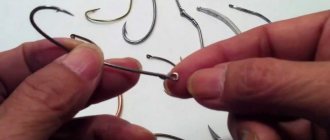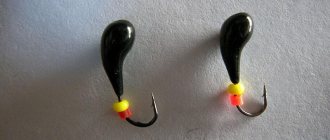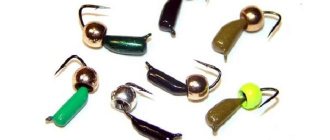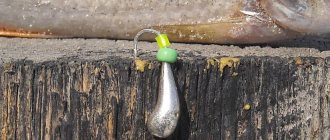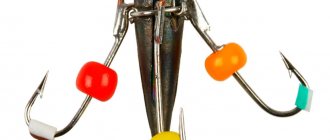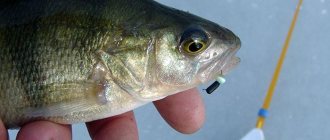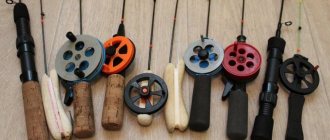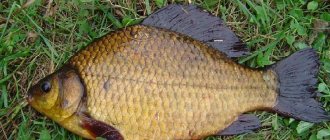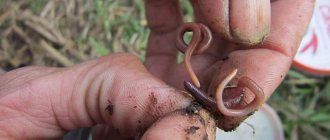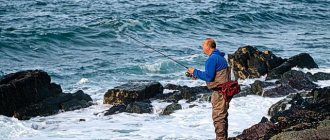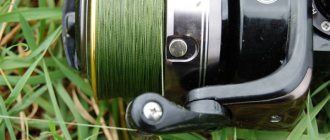Mormyshka
is a small weight of a certain shape, size and color, made of tin, lead, copper, tungsten, stainless steel or their alloys, with a hook fixed in it and a hole for tying to a fishing line.
The shapes of jigs are varied, but some of them are the most popular - “pellet”, “droplet”, “ovsinka”, “klopik”, “bean”, “lentil”, “cone”, “rhombus”, “grushka”, “uralka” , “ant”, “goat”, “devil”, “witch”, “dracena”, “nymph”, etc.
Content
- 1 Description 1.1 Material
- 1.2 Shape, color, size, weight
- 1.3 Hook
- 1.4 Equipment
- 2.1 Jigs for fishing with attachments
- 3.1 Basic techniques for playing with a jig
- 4.1 Sawing the jig
Jigs with bait - what are they?
A good jig is not only a tungsten version, but also a classic one. This is exactly what elements with bait refer to. This method of fishing is welcomed by many anglers, because it involves adding additional bait, in the form of the same bloodworm, for example. With a good bite, the “duet” copes with its task perfectly. In addition, such baits have a low price, and if necessary, creating such jigs with your own hands is also not difficult.
The baits of the presented plan are divided into:
- A pellet. This bait is considered one of the most popular. It is round and bright. They often use this jig to catch roach or perch.
- A drop. The name speaks for itself - this concerns the shape of the product. Such elements are good because with their help it is much easier to play the game. Experienced fishermen claim that even in a bad bite, the “drop” saved them, bringing at least some catch.
Description
Material
Mormyshka
As you know, the overwhelming majority of jigs are made from either lead or tungsten. Of course, there are other metals (for example, silver) or alloys (for example, Wood's alloy) from which jigs are made, but in their shape and play they are not much different from lead, and the main difference is that they have greater specific gravity or increased resistance to corrosion. It is also very common to find jigs, which consist of a crown (usually white or yellow metal) soldered into lead.
Which material should you prefer?
- Lead
is the most versatile metal, which allows you to make jigs of various types and varying complexity, and, most importantly, this can be done at home. The main disadvantage is that, with small sizes, the jig is quite light and when fishing at depth, the jig sinks for too long, and when fishing in the current it quickly gets carried away...
- Tungsten jigs
are much heavier in specific gravity than lead jigs of the same volume. But, unfortunately, the main disadvantage of tungsten is that it is very difficult to process, although recently tungsten jigs of various shapes have begun to appear. Tungsten jigs are most suitable for fishing at depth and when fishing in medium or fast currents.
Shape, color, size, weight
The history of the development of the jig goes back several decades, and during this time the main types of forms have been developed, which have become classic today.
What shape of jig is optimal? This question is asked by any novice angler and hopes to hear a definite answer. But just as there is no universal attachment or spinner, there is also no single jig shape that would be ideal in any situation.
Of course, there are certain criteria when choosing the shape and color of a jig, but the most important criterion should be the experience of the fisherman himself. Today there are all kinds of jigs on sale and the choice is huge, but choosing that one jig that will be “super catchy” is not easy. The fisherman himself must experiment with different types of jigs and draw conclusions. After just one season of active fishing, he will have a lot of information about the catchability of certain types of jigs, depending on the reservoir and fishing conditions.
After this, the fisherman often concludes that there is no ideal jig available for sale and that he needs to create or modify the jig himself so that it is most suitable for specific fishing conditions. And this approach to choosing a jig is the most correct!
But still, what type of jig should I start with? We can only say one thing – from anyone! Take any jig that you like and try it in action. The only thing I would like to say is that it is better to start with small jigs and preferably dark (black) in color.
As “quite universal” jigs for beginning anglers, we can also recommend “oat” shaped jigs. As for the choice of jig color, it can be noted that light jigs are best used when fishing in muddy water or in cloudy weather, and dark jigs are best used in light water or when fishing during the day in sunny weather, and also if there is a light (for example, sandy) material. bottom.
When fishing at great depths, color is not an important criterion at all, since the fish simply does not distinguish it, but reacts mainly to the vibrations (play) of the jig.
The size and, accordingly, the weight of the jig is selected based on the fishing conditions. In this case, it is necessary to take into account the depth of fishing, the presence of a current and its strength. When fishing in a current, the weight of the jig should be such that it is possible to lower the jig into the water and make at least one full retrieve, that is, lower the jig to the bottom and raise it to the surface.
Recommendations for choosing jig weight:
- for catching bream and roach, a small but heavy jig is best suited;
- heavy jigs are good for fishing on relatively thick fishing lines with bait;
- heavy jigs allow you to quickly deliver the bait to the right place;
- small jigs (up to 0.25 g) attract small fish at a depth of up to 2 meters;
- large jigs (more than 0.25 g) attract predatory fish at a depth of 3-4 m;
- on the first and last ice, the use of large models of jigs is justified;
- a light jig provides a more delicate game.
Recommendations for choosing the color of the jig:
- the silver, black or red body of the jig serves as an additional guide for fish in search of food;
- black jigs are the most versatile, but they are most effective when used in the spring;
- Copper-colored jigs are suitable for fishing at great depths;
- for catching roach and perch, choose medium or large jigs of brown, dark green, dark purple, brass color;
- the lighter the water, the colder the color of the jig should be;
- the more snow on the ice, the lighter the jig should be, and the less snow, the darker the bait, even black;
- In the morning in shallow water it is better to fish with a shiny bait, in the middle of the day with a dull one;
- at a depth of over 10 meters, the color of the jig does not matter.
Recommendations for choosing a jig shape:
- In order for the jig to attract the attention of the fish with its action, it must be sufficiently voluminous and capable of generating noticeable vibrations;
- a jig flattened at the top and bottom raises a cloud of turbidity on the muddy bottom;
- “droplet” and “pellet” create light fountains of turbidity at the bottom;
- a flat jig forms noticeable clouds of turbidity on the bottom and at the same time seems to disperse them, suitable for catching roach and perch;
- nodding movements are effective with the “Ural” jig and the “ant”;
- the cone-shaped jig, having sunk to the bottom, enters the upper layer of silt;
- “droplet”, “ovinka”, “pellet” are irreplaceable in the wilderness;
- perch, roach, bream, chub are caught using the “devil”;
- jigs in the shape of a droplet or a ball are the most versatile.
Recommendations for choosing jig size:
- The size of the jig is selected depending on the depth of the fishing spot and biting activity;
- when the bite is very weak, super-small tungsten jigs with a diameter of 1.6-1.8 mm are often used;
- Fishing with small jigs takes place in still water, at depths of no more than 2 meters.
Hook
The hook is the most important element of the jig. If you have picked up a catchy jig and the bites follow one after another, but each time there is either a hit on the lips or a slip when hooking (fishing), then this means you have a bad hook!
Unfortunately, with all the richness of the choice of types of jigs, the weakest point is the hook. With rare exceptions, you can find jigs with hooks from Gamakatsu, Mustad, VMC, etc.
Always check the sharpness of the jig hook, it should be maximum. To do this, it is recommended to always take a hook sharpener with you.
If the hook is sharp enough, and the number of slips increases, then you need to slightly bend the hook tip towards the jig.
If possible, it is better to choose steel wire hooks rather than hardened iron. This is due to the fact that with a “dead” hook, the forged hook simply breaks and you lose your favorite jig, but with a wire hook there is a chance that the hook will simply straighten out and you will release the catchy jig.
Equipment
By equipping a jig, we mean equipping the shank of the hook with various cambrics or beads. Equipping a jig is especially important when you are fishing without a nozzle.
The simplest equipment can be considered when a piece of wire insulation (cambric), most often red or yellow, is put on the forend. When fishing without bait, it is better to place one or two beads in front of such a cambric.
It should be noted here that the color of the beads is not of fundamental importance; their main task is to add vibrations when playing with a jig in the water, which attract fish and make them instinctively grab the jig.
If fishing is carried out with a nozzle, then in this case you don’t have to equip the hook shank with additional cambrics or beads at all.
Nozzle jigs
Any model of this type of jig is characterized by a basic property - their use does not involve the use of natural bait, and their attractiveness is ensured only by the unique nature of the bait’s play in the water.
Among the reelless jigs, the most popular types are:
- Uralka is popular among those who like to hunt perch. Fishing tackle stores usually offer a large selection of this type of reelless hook, differing from each other in size, color, and the presence of beads of different shades at the base of the hook;
- devil is the most catchy bait for pike perch, equipped with three or even four hooks;
- goat is a type of devil, although many distinguish it as a separate independent species. This jig is made primarily from copper or brass. The number of hooks a goat has is less than that of a devil, and in order to ensure effective fishing with it, you need to know the intricacies of placing the bait;
- boat - designed for catching peaceful fish, therefore it requires active wiring. Its colors are quite diverse, and the design is improved with additional elements that attract the inhabitants of the aquatic depths;
- ant is a bait with a body divided into segments. Its very name indicates the similarity of the jig to a living insect, and the nature of the movements with a small amplitude exactly imitate the behavior of an ant that has fallen into the water. All baits of this type have approximately the same weight - 0.3 g, although it can be increased by adding beads to make it heavier;
- donkey - a bait similar to a quarter of a coffee bean, mostly black. It is considered almost universal, since it has shown itself well in and without current.
Read more
How to catch bream with lard?
But no matter which of the listed types of baitless jigs the fisherman chooses, he will be able to determine the catchability of the bait only by testing in practice, under certain conditions, fishing on a specific body of water.
Nozzle jigs
Types of jigs
It is almost impossible to talk about all the types and forms of modern jigs, due to the fact that they are constantly being improved. Perhaps the most common, classic form of jigs is a ball (“pellet”) and a drop (“droplet”). Of course, there are a huge variety of other forms: various “ants”, “devils”, “goats”, but a novice fisherman first needs to master simpler models.
According to the method of fishing, jigs can be divided into two categories:
- jigs for fishing with attachments;
- jigs for baitless fishing, the so-called “reelless”.
Jigs for fishing with attachments
Types of jigs Jigs “shots” are mainly used for fishing with a nozzle and come in two types: with a through hole and with a loop.
These jigs are made from lead or tungsten (there are copper and silver models). Recently, tungsten jigs have become more popular because they weigh more than lead jigs, although they are more expensive. For fishing at shallow depths, there is no fundamental difference which lead or tungsten jigs to use. If fishing is at great depths, and there is also a current, then tungsten jigs are often more effective. On the other hand, when fishing without bait, lead jigs often work much better than tungsten jigs.
When choosing tungsten jigs with a hole, it is better to choose those with a cambric inserted into the hole, since tungsten is much harder than lead and the cambric will protect the line from rubbing against the edges of the hole. Another important point is the size of the jig. For most reservoirs and fishing conditions, pellets with a diameter of 2.5-3 mm are suitable. Larger jigs may be needed for fishing at depths of more than 5 m or in currents. Miniature jigs with a diameter of 1.5-2.2 mm. used mainly for sport fishing.
The second popular form of jig is a drop, the so-called “droplet” jig. Tungsten drop jigs are used both when fishing with bait and in fishing without bait. The criteria for choosing a “droplet” jig are similar to the selection of spherical “pellet” jigs. You just have to take into account that a “droplet” of the same diameter as a “pellet” has more weight, so under the same conditions you need to use droplet jigs of a smaller size than “pellets”. Otherwise, these jigs are very similar, and they can be used with approximately equal success for fishing with bait for various types of fish in different conditions.
Regarding color when choosing a jig, for fishing with a bait the color of the jig is rarely the determining factor. Under certain conditions, dark jigs of a natural color are more catchy; sometimes jigs with a shiny surface bring success. Therefore, it’s a good idea to have jigs of different colors in stock and directly experiment while fishing which jig and what color will be more catchy.
Nozzle-less jigs or “reelless jigs”
Reelless jig equipment These jigs differ significantly from models used for fishing with bloodworms or other natural baits.
In fishing with baitless jigs, the main thing is the action of the bait, which is noticeably influenced by cambrics, beads, chains and other “decorations” placed on the hook. As a matter of fact, the attractiveness of bait for fish largely depends on them. Nevertheless, the size, shape and color of the body of a nozzle jig often play an equally important role, and the variety of options here is very large. Most “reelless” jigs are designed for gliding play: the role of a kind of wing is played by the flattened front part of the jig’s body. This bait has its own game, which complements the vibrations set by the guard. For fishing without bait, lead jigs are traditionally used: “ant”, “devil”, “uralka”.
Usually, nozzle jigs are made of lead: in this case, the high specific gravity of tungsten becomes a disadvantage. True, tungsten models with an enlarged flat also appeared, but their performance depends more on the round plates placed on the hook. Moreover, you must constantly ensure that the cambric that holds the records in place does not limit their freedom of movement, otherwise the game will be lost. Most of these baits have a soldered hook, to the eye of which the fishing line is tied. This type of fastening is more reliable than the traditional one where the fishing line is passed through a hole in the body of the bait.
As a rule, “reelless” jigs are larger than “regular” jigs and are designed for catching more marketable fish. “Reelless” baits work well on large roach, perch, and bream. Since these baits largely imitate aquatic insects and their larvae, the main colors of jigs are dark green, purple, brown and black. Copper-plated and gold-plated rewinders also work well.
Much more varied than the colors of nozzle-free jigs are various refills - beads, seed beads, cambrics and others. Often the final result of fishing depends on the color or even their shade. Often two-colored, striped and asymmetrical beads are used, which play when wired. According to the experience of many anglers, cognac colors, dark brown and purple, clear or yellow striped, work well on a reelless bait. In general, contrast often gives results.
The classic colors of beads on reelless fish are white, yellow, red and their combinations, sometimes with the addition of green: this range works on most bodies of water. In general, many variations have been invented, and although they, first of all, “catch,” of course, the buyer, this variety still makes sense.
There are many models of jigs for baitless fishing with flies tied to a hook. But this is exactly the case when the bait is more designed for the attention of the angler, rather than the fish. The exception, perhaps, is the only jigs made by fly fishermen and subtly imitating some kind of aquatic insect. Such jigs catch very well, but are extremely rare and, as a rule, are made only to order.
Winter jigs
Winter jigs are used for catching not the most active fish. They are small in size and colored in such a way as to attract fish from afar. Usually they put some kind of attachment on them.
Types of winter jigs:
- jig for catching perch. Its dimensions range from 2 to 6 mm; usually bloodworms are attached to it.
- jig for catching pike perch. This is the largest winter jig. It has a slightly oblong shape and is usually painted white.
- jig-clamp. This bait is used when fishing for small bait, which is very difficult to put on a hook.
- nozzle jigs. The main difference between a jig for fishing without a nozzle is the ratio of the body of the jig, hook, beads and cambrics, which additionally attract fish. Fishing with a baitless jig is a simple, productive and at the same time economical way of fishing. The most common types of such baits are: “ant”, “uralka”, vertical jigs.
Summer jigs
Summer jigs are large in size. They differ from winter ones in color. The most widely used jigs in the warm season are red-brown tones. In summer, they are good for catching crucian carp, perch, and pike perch.
You can fish with a summer jig anywhere. You just need to find a promising place and fish it. The catches of such gear will always be greater than those of floaters in the same place. By conducting a jig like winter fishing in different horizons of a reservoir, you can seduce even the most passive fish, which cannot be done with float tackle.
Winter jig. How catchy and how to choose the right one.
Winter fishing is a hobby for people with a strong and seasoned character. After all, unlike in the summer, when the sun is pleasantly warm and your fingers don’t turn red from the strong icy wind that pierces your bones, in winter you can’t really sit in one place waiting for a bite. To find a fish, you will have to work hard, drilling or punching holes, and sometimes walk several kilometers along an ice-covered body of water. But the reward for your efforts will be much sweeter and more enjoyable.
Only a real fisherman can understand that indescribable feeling of delight when you pull a fish out of a hole using the thinnest fishing line, like a gossamer line. Even a specimen weighing only one hundred grams,
which I would not pay any attention to in the summer, can cause a storm of emotions and an influx of adrenaline in the blood. And this is not to mention the trophy specimens, fighting with which will be a real pleasure.
And for winter fishing to be successful, you need to pay special attention to the bait.
A correctly selected jig is a guarantee of successful fishing. The main thing is not to make a mistake with the choice. Today you can buy any jig in stores, and often beginners begin to get lost in this abundance of baits, not really understanding which one will be the most catchy.
In order to feel more confident in front of the counter, you need to know the features of certain jigs.
Types of jigs
All jigs can be divided into two main types - baitless and those that are useless without bait in the form of bloodworms, maggots, dough, etc. Describing all the models and shapes of modern jigs is a labor-intensive task and simply unrealistic. However, there are a number of time-tested artificial baits that simply must be in the arsenal of every self-respecting fisherman - “pellet”, “drop”, “ant”, “devil” and “goat”.
Jigs with nozzle
The main function of these jigs is to deliver the bait to the bottom. Such jigs are used with conventional rods with nods. The color and shape of jigs with attachments do not particularly affect the fish’s bite. Basically, they are equipped with single hooks, onto which beads, seed beads, multi-colored threads, tinsel, etc. are attached for better attractiveness. The fact that bait is attached to the forend of the hooks of such jigs does not mean that the fishing technique on them excludes the game. The movement of jigs with a nozzle should be smooth and with a large amplitude of movement up and down. It happens that fish also bite on a stationary bait, coveted by the bait, but this happens most often during active biting.
There are a huge number of types of jigs with attachments, but the main ones are “pellet” and “drop”
The “pellets” exist with a loop and a through hole in the middle of the body. They are made from lead or copper, and wealthy fishermen can purchase tungsten and even silver ones, which, despite their small size, weigh much more than their lead “brothers.” The difference in weight is felt when fishing at great depths. If in shallow water the weight of the jigs does not play a special role, then at depths of over three meters and in the current without tungsten or silver jigs, catching fish will become very problematic. The size of the jig can partially help solve the problem, but if the bite is weak, the fish simply will not pay attention to overly large and bulky baits.
“Drop” is a more universal form of jig than “shot”, since you can fish with it both with and without a nozzle. In this case, the weight of the “drop”, due to its pear-shaped shape, will be slightly higher than the weight of a round “pellet”.
On lakes or rivers with a slow current you can fish with small and medium-sized jigs. They have a brighter and more attractive game, which even beginner jig players can master. But only experienced fishermen who are familiar with all the nuances of guiding large jigs at great depths can cope with heavy and bulky baits, which are used for fishing in rivers with fast currents.
Nozzle jigs
The very name “baitless jigs” implies that fishing with this type of bait occurs without baiting a hook. Here the color, shape, and size of the jigs come first. Most often, nozzle jigs copy the appearance of insects or their larvae. Albeit very distantly. The best rod for fishing with baitless baits is the classic “balalaika”, as thanks to it you can quickly react to the slightest touch of a fish on the jig. The rod should be made of frost-resistant material, and the nod should be chosen softer. Fishing with baitless jigs is one of the most active types of fishing.
The most catchy baitless baits include the following types of jigs:
• “Devil.” Outwardly, it looks a little like a drop with a three-piece at the end, thanks to which the jig can only be inserted in a vertical position. The game is fast with frequent fluctuations.
• "Uralochka".
The shape of the “uralochka” is a drop with the ends curved upward. During active play, the “Uralochka” moves in any direction - both horizontal and vertical.
• "Bolda". Naturally, it’s not the “bullshit” that is used when trolling a predator, but its smaller brother. The so-called “micro bulldozer”. Cambrics and beads are attached to hooks movably fixed above a cone-shaped or oval weight. The hooks moving in the water when fishing are like the legs of an insect, which no self-respecting fish will swim past. The game is active, with frequent hits on the bottom, simulating an insect burrowing in the ground, and periodic rise almost to the surface of the water.
• "Ant". This jig consists of several welded balls of the same or different sizes, resembling an ant in appearance. Usually comes in black color. The hook is single, soldered into the body of the bait. The game is active.
• Other shapes resembling geometric shapes - triangles, squares, diamonds, ovals, disks, trapezoids, crystals and nail balls - During the period of passive biting, it is these unusual jigs that can provoke fish to attack the bait. Retrieving is fast, aggressive, with frequent oscillations.
Which jig to choose in a particular winter period
During the period of first ice, when the water is still adequately saturated with oxygen, the fish behave quite actively. At such times, you can fish with any jig, without particularly paying attention to their color, shape and size.
In the dead of winter, fish move to holes where there is a little more oxygen. The bite during this period is very sluggish. Each caught fish means a lot of effort and hours of waiting at the hole. At this time it is better to fish with the smallest baits. The game is as sluggish and passive as a fish. If there is no bite for a long time, then it is better not to sit in one place, but try to find fish in another.
Along the last ice, fish activity increases again. Thanks to the oxygen entering the water, it begins to move around the reservoir in search of food. However, it is better not to use large jigs, but to opt for medium and small ones. This is due to the fact that by this time the fish’s belly is usually already filled with caviar, and as a result it is unlikely to covet large prey.
How to tie a jig correctly
Beginners often wonder how to properly tie a jig to a fishing line so that it does not come off at the most inopportune moment - when hooking or landing a fish. There are several ways to attach baits.
• If there is a through hole in the jig, then the fishing line must be passed through it and then tied to the hook.
• If the jig has a special eye for attaching the fishing line, then it is to this that it is tied with any knot familiar and familiar to the fisherman.
The only condition is that before tightening the knot, the fishing line must be moistened with water or saliva. In this case, it will not overheat or deform, which will make your unit stronger and more reliable.
And finally, a photo for those who say that you can’t catch tench from the ice -
(not mine, but the fact of capture is there, so it turns out it’s possible!)
Jig fishing technique
Fishing technique with a jig *Having found the desired depth of descent, place one or more bloodworms, thistles or mayflies on the jig. The jig is lowered to the bottom, controlling the descent with a nod. Then shake the jig at the bottom, knock 5-10 times so that a cloud of turbidity rises. Start lifting with rocking at a fast pace with an amplitude of oscillation of the rod tip of 1.5 cm. Raise the jig to a height of 50 cm and wait a pause of 2-3 seconds. Lower the jig to the bottom on a bent nod. After 5-10 cycles, you need to try to change the pace of the game and reduce the amplitude of vibrations, raise the jig higher.
- Lower the jig with bait to the bottom. Raise the jig 1-3 cm and begin a leisurely rise, playing with the tip of the fishing rod at a pace of 90-120 times per minute and an amplitude of 0.5-1 cm. Stop the rise every 3-5 cm, shaking the jig 2-3 cm. At a level of 60-70 cm from the bottom, finish lifting and lower the jig for a new cycle.
- Lower the jig to the bottom. Swing the jig, lifting it 0.5-1 cm above the bottom. After 3-4 cycles, pause for 5-7 seconds. All movements should be slow. After 1-2 minutes, direct the fishing line to the edge of the hole. Without stopping playing with the jig, pull the line to the other edge of the hole. This is a good technique for fishing with a jig when the fish are sluggish in the dead of winter.
- Lower the jig to the bottom. Raise it 3-5 cm and play it like a spinner 3-5 times. Hang above the bottom and pause for 2-4 seconds. Start lifting, slowly accelerating, and leave the jig 40-50 cm above the bottom. Then lower it in jerks by 2-3 cm with a pause of 2-3 s. Leave on the bottom for 3-4 seconds. This technique of fishing with flat jigs is suitable when the fish is quite active.
- Reelless jig fishing. The jig sinks to the bottom. Then a slow rise begins with trembling oscillations, the rate of which is 100-300 times per minute, the amplitude is no more than 1 cm. The slower the rise and the shorter the amplitude of the oscillations, the more often fish bites occur. If there is a failure in tempo, it is better to start lifting the jig from the bottom again. This technique of fishing with a jig brings success all winter, with the exception of the middle of winter - the time when fish are most unbiting.
- The jig is raised above the bottom by 0.6-1 m, and the game begins. The jig is lowered by 2-3 cm and, holding it, pause for 2-3 seconds. During the pause, they rock gently. Having reached the bottom, pause for 3-4 seconds and move the jig, repeating this 5-6 times. The jig is slowly lifted from the bottom 0.5-1 m.
- The jig is lifted from the bottom slowly. Swing the tip of the winter fishing rod at a rate of 10-20 times per minute with an amplitude of 2-3 cm. Stop the rise after 15-20 cm and pause for 2-4 s. You can not raise it above 60 cm.
- Moving the jig on the bottom, he moves the tip of the winter fishing rod from edge to edge of the hole crosswise. This jig fishing technique is called “crossing the hole.” White bream, ide and chub are caught.
This jig fishing technique is not exhaustive. An angler can look for his jig fishing technique. But we must also be guided by general principles. The technique of fishing with a jig should depend on the time of year, the fish you are going to catch, and the weather. If there is no oxygen deficiency in the reservoir, when there is first ice or in the spring, jig play can be more active. If there is a lack of oxygen and fishing with a jig in the middle of winter, before the snow begins to melt, it is necessary to sharply reduce the amplitude of oscillations of the winter fishing rod and reduce the activity of the game.
Basic techniques for playing with a jig
When all the preparations are completed and you finally find yourself on the ice of the reservoir, you can start fishing directly. After making several holes in different places, feed them with a small amount of bloodworms. Then return to the hole you drilled and baited first, and start fishing. Bait one bloodworm on the jig hook. The bloodworm can be worn in different ways: behind the head, in the middle, as a stocking, or as a ring. I like the ring method most of all, when the larva is carefully threaded with a hook at the head and tail. We lower the jig into the hole and unwind the line from the reel until the bait touches the bottom. This moment is determined by the sag of the fishing line and the change in the bend of the nod. Adjust and fix the length of the fishing line by clamping the spool. Remember: the fishing rod should be as close to the hole as possible, especially if there is wind. If there is no wind and you are sitting on a high box or chair, then it is acceptable that with the jig lying on the bottom, the nod should be 20–30 cm above the ice. Start retrieving by smoothly and slowly tapping the jig on the bottom. Then slowly raise the jig 30–40 cm, making smooth rhythmic swings with the rod. Make the next wiring faster with an increased oscillation frequency. Then try to hold the bait at the top point of the retrieve for a few seconds and begin to slowly lower it to the bottom, making one or two short stops. Again, tap the bottom several times and hold the jig at the bottom for a while without moving. If after all the manipulations there is no bite, you need to move on to the next hole. In winter fishing, the rule “the legs feed the wolf” works, and usually the number of holes drilled is directly proportional to the weight of the catch.
Tips for choosing jigs
Each jig model combines its parameters in a very unique way, from shape and weight to additional accessories - artificial and natural refills. How to make the right choice in this variety of options, and what properties should be taken into account first?
Hooks on a jig
Hooks should be sharp, strong and thin enough. It is difficult to place bait on jigs with blunt and thick hooks without damaging it, and it will be almost impossible to successfully hook.
Good quality hooks are made from steel wire. For greater strength, it can be hardened, but when the hook is overheated, it becomes brittle, which is unacceptable. Therefore, when choosing hooks, you need to pay attention to the period of use, hardness and strength, since soft hooks that are easy to bend are not suitable for such bait.
Material
Jigs are most often made from tungsten, lead or tin, and less often from other metals.
Each material provides the bait with its own special properties:
The hooks on the jig should be sharp, strong and thin enough
- Tungsten is a dense metal, so even a small jig will have a significant mass. They are used at great depths and currents. In addition, tungsten baits sink quickly after casting and if the retrieve is successful, there is a good chance of catching roach, bream, rudd, ide and striped predator - perch;
- lead - jigs are made from it when tungsten turns out to be too heavy a material for catching fish that are too picky and finicky. The advantages of lead jigs include their low cost, smoother play and many available modifications of this type of bait;
- Tin is a soft and ductile metal. Lures made from this material are easy to use, have the smoothest play, are light and small in size;
- other materials (copper, chromium, silver and their various alloys) are used if corrosion resistance is greater than that of other types.
Jig color
This parameter is important if the angler plans to fish at a depth of less than 10 meters, and at shallower depths the following tips are relevant:
- Black jigs are universal and are most often used in the spring;
- Copper shades of bait - for fishing at depth;
- Green, brown, purple - relevant if hunting is for perch and roach;
- Lures of cold colors - for fishing in clear water;
- Very light jigs are suitable for ice fishing when the snow cover on the ice is large enough;
- Shiny baits are suitable for fishing in the early morning, while duller ones are suitable for fishing in the afternoon.
Weight and size of jig
These parameters are important and are selected primarily taking into account fishing conditions - depth, current and size of the expected catch.
The weight and size of the jig are selected primarily taking into account the fishing conditions
A large tungsten “droplet” will be indispensable if an angler hopes to catch large bream on the current in a deep reservoir. At the same time, heavy jigs are not suitable for shallow water fishing. Here it is better to give preference to a small nylon bait.
Connoisseurs of the intricacies of jig fishing strongly advise having in your arsenal several baits of different weights and sizes in order to be able to select the most catchy one on a particular body of water, having tried each of them in practice.
In general, a rational ratio of the weight and size of a jig can significantly influence the outcome of fishing - if you make the wrong choice, the process of fishing with tackle equipped in this way will become an unpromising and fruitless activity.
Form
When choosing the shape of the bait, you can use the following principles:
- In order for the jig to fully fulfill its function of attracting fish, it must be noticeable;
- if a fisherman doubts the choice of bait shape, you should start with the universal ones - “droplet” or “ball”;
- a jig flattened at the top and bottom will lift sediment from the muddy bottom and create excessive turbidity in the water;
- It is advisable to use a flat jig when wanting to catch roach or perch;
- a cone-shaped jig cannot be used if the bottom of the reservoir is covered with a thick layer of silt, since when it sinks to the bottom, it will sink in it;
- “droplet” and “pellet” are most often used in ice fishing;
- Perch and chub are successfully caught using the “devil”.
Read more
What to feed carp with?
DIY jig
There are craftsmen who make baits at a high, high-quality level. The names of these masters are familiar to large fishing circles. Their products are always popular and local fishermen speak of them in legends. Any novice angler can make a jig with his own hands, which is not particularly difficult. Some are quite basic and easily accessible. Here are some of them:
Sawing a jig
Sawing jigs is one of the easiest ways to make a jig. Rods and tubes made of non-corrosive steel, copper, bronze are sawed with a metal jigsaw into a variety of pieces. Hooks are soldered to the acquired figures, after which finishing is done and various coatings are applied. To do this, use various tinsel and colored stickers.
Soldering jig
Using thin plates of tin, sheet copper and other similar materials, you can create jigs of various shapes. A bag, cylinder, or tube of suitable sizes is constructed from foil. A hook is inserted inside these molds and everything is soldered. Foil figures can be easily processed, giving them the most unusual shapes. An elementary example: before creation, a screw is rolled over the foil. This will undoubtedly help create a jig that resembles some insects and their larvae. Filling the resulting grooves with solder and then polishing it will help transform the pattern. Wonderful summer crucian carp jigs are produced by pouring lead into spirals of copper wire, which is also easy to make using a soldering iron. After filling with solder, they are polished until copper ribs appear against the background of lead, which have a copper-red color. Good jigs, similar to pupae of flies, worms and larvae, are obtained by preparing them from copper, bronze, brass, and aluminum wire. It should be quite thin, no more than 0.5 mm thick. Cylinders, bags, worms, etc. woven from such wire. supplied with a hook. It is placed inside these structures and crimped with wire when winding the form. A regular sewing needle is inserted into the ring of the hook to hold the hole when soldering the mold, after which the entire mold is filled with solder. Finishing of the jig involves grinding the purchased workpiece with sandpaper, and then with a felt wheel, until a clear “golden” or “silver” pattern appears on the body of the jig. A similar pattern on the body of the jig makes its play particularly attractive to fish. The grayish background of the solder and the reddish pattern of wire rings are especially valuable when creating summer jigs.
Casting jigs
Casting jigs Casting jigs begins with a blank figure for pouring the liquid alloy.
For this purpose, brick, clay, chalk, alabaster, aluminum and even wood are used. Good effects can be achieved by using copper-graphite brushes (current collectors) of electrical devices and machines to prepare figures. If you can find ones that are suitable in size, allowing you to make recesses of up to 5-8 mm in them, then this greatly simplifies the work. A selection of recesses for the shape of the jig that you like or have invented yourself is made in accordance with the properties of the material used for this. In the case of a copper-graphite plate, brick, or clay, this will not present much difficulty. It is not difficult to find a cutter of suitable hardness and perform this work at a fairly high level. Another thing is making a mold from an aluminum plate. This especially affects some aluminum alloys, which are difficult to distinguish from the outside from a pure alloy, but whose hardness is often very high. In this case, either a sample is made with a drill, or, using suitable sized metal balls from bearings, the molds are squeezed out. By placing the balls between the aluminum plates, the plates are crimped in a table vise. With this method it is possible to produce the most diverse sets of spherical figures. The resulting depressions must be further processed in order to eliminate the resulting edges. This is necessary so that the fusion of the plates is as strong as possible. The easiest way to make molds is from wood. True, they are less reliable. This work is done with a specially made tool, for example, from a drill that has served its life. Its working part, due to its high hardness, will make it possible to easily create samples even in hard wood. Ready-to-use plates with half-molds should fit closely to each other. Having cut two grooves from the edge of the plates (for pouring metal and for releasing air from the mold), you can begin casting jigs. The melted metal is poured into prepared molds. After it has cooled, the plates are separated and the resulting cast jigs are processed clean with a file and sandpaper. Of course, you will ask the question how to tie it? The answer is simple: cut out two blocks, drill holes along the edges, cut out the shape of our future jig from the wire, heat the wire on the fire, insert the wire into a wooden mold, squeeze it and get a mold for casting the jig, see which side is burned deeper, build a slot for the hook so that it lay tightly there, squeeze the two halves and fill it with tin and buy a jig, clean it and make the hole at the angle you need, that’s all.
Designing a jig
From a ready-made branded jig and certain ordinary materials, you can create an entertaining and catchy jig. For example, take a large drop-shaped jig and equip it with a fish cut out of plastic. This stylized fry must have a brilliant color. He plays well on the hook and has the ability to be a catcher under certain conditions. What are these conditions? First of all, the right choice of fishing object. The best use for the jig provided will be for bream fishing. From research it is clear that bream in a flock compete enviously for food. At the slightest opportunity, large individuals push aside the smaller breams and snatch prey right out of their mouths. A small plastic fish, making oscillatory movements at the very hook of the jig, amazingly plays the role of an easy victim of this competition at the feeder. They will certainly try to squeeze it and tear the prey out of its mouth, in this case a hook with a bloodworm. Excellent effects are achieved by coloring jigs purchased or made with your own hands. The jigs are painted with nitro varnishes, for example, nail polish. Its pearlescent tones are especially good when creating perch jigs. The hooks used when designing jigs, since these are usually small hooks, should be checked for the quality of their sharpening using a powerful magnifying glass. It is important that they do not have sharp edges or burrs.
Choosing a jig
The choice of jig directly depends on what kind of fish and where you are going to catch. If we are talking about large fish, then you need to understand that it must have a large hook on which it is convenient to place the bait and from which it will not fall off.
It is believed that larger fish prefer natural bait rather than artificial bait. If fishing will take place on a river where there is a current, then you need to use a jig made of heavier material (lead, tungsten).
Today, the most common materials from which the jig body is made are considered to be tin, lead and tungsten. These materials can be used in conjunction with silver, brass and copper plates.
The shapes of jigs can be varied:
A jig with one hook can be in the form of a pellet, a “chechkvichka”, a droplet, a grain, a pear, an eye and a larva.
A jig with two “goat” hooks usually looks like an inverted drop or grain of wheat.
A jig with three “devil” hooks has the same shape as a “goat”.
The sizes of jigs with a single hook can be very different. It depends on the method and place of fishing, the size and type of fish, as well as the time of year:
- Today, nozzle-less jigs (reelless jigs), with small hooks (No. 2-3.5), on which various beads, cambrics and colored plates are put on instead of a nozzle, have become widespread. It is more effective to fish with such tackle at a depth of 3-3.5 meters, since they are usually light (with the exception of tungsten). But adding a sinker is not advisable, since the tackle becomes less informative. When fishing with a “reelless” bait, the tackle must be very sensitive, since the fish, having swallowed such a jig, quickly understands the catch and tries to spit it out. At this time, you need to cut.
- With jigs with medium hooks (No. 3.5 - 5) they fish with bait (bloodworm, jig, maggot, worm, burdock, dough, bread). The depth of their use is limited to 5-6 meters.
- For larger fish, heavy lead or tungsten jigs are used. Larger fish are found at depths of more than 6 meters. These “spinners” are equipped with large hooks (No. 6-8), as they are baited with bunches or in the form of a “sandwich” from various baits.
- The goat fish is fished under almost the same conditions as the mothless fish. Hooks can be No. 4.
- They fish for the “devil” like a “mothless” with hooks up to number 4, and from the 5th number they already hook bloodworms, maggots, and burdocks onto one of the three hooks. The “devil” is sometimes used to effectively catch large bream from the bottom, but the bait is put on all three hooks.
Methods for tying a jig
Methods for tying a jig Everyone is familiar with the situation when, after the next hook, a fisherman is left without a trophy and without a jig.
And the point here is often not that a large fish bit, but simply, after several fishing, the line rubbed against the sharp edges in the hole of the jig. The cause of the breakage can be all kinds of burrs. This is especially true for jigs with a brass, copper or other shell, as well as baits made of hard alloys. Therefore, having purchased a batch of jigs - factory-made or homemade, you must first of all carefully inspect the edges of the holes for passing the fishing line. If they are sharp or have burrs, you should do this. Make appropriate recesses in a wooden block, place jigs in them and carefully countersink the holes and then process them. There are several methods, but this is considered the most reliable. First pass the fishing line through the hole of the jig so that the length of the free end is sufficient for tying a knot. Then lay the fishing line in a loop along the shank of the hook and press it with your index and thumb to the shank, but so that between the body of the jig and your fingers there is space for winding the fishing line. With the other hand, make 4-5 turns of the fishing line around the forend, pull the free end of the fishing line into the loop. Holding the winding on the loop with your fingers, grab the main line and tighten the knot. The strength of the knot must be checked.
During the fishing process, the reel can spread. To prevent this, do this: after cutting off the excess fishing line near the knot, be sure to melt the remaining tip with a heated needle at home or over the fire of a match in a pond. After finishing fishing, it is advisable to re-bandage the jig.
Reviews about the use of jigs from fishermen
Nikolai Belov says: “For many years I have been using the same jig shape. (We are talking about an oval shape.) When fishing, I place it so that it has a horizontal shape. Sometimes I use attachments in the form of beads, cambrics and other types.” Grade:
Peter Firin: “I respect the devil jig, but I avoid it because during winter fishing, half of the bites are missed due to the hook clinging to the edges of the hole.” Grade:
Toivo Kaoläinen: “From my own experience I can say that larger jigs of dark colors work well on the first and last ice. At this time, the perch is quite active. All that is important for me to get from it is a high dive speed. Jigs made of tungsten are perfect for this.” Grade:
Sergei Nikonov shares his experience: “I always have a “bug” jig in reserve. It is good for bream and large roach. Even winter crucian carp bites well on it” Rating:
Ivan Krepov recalls: “My first jig, with which I started, was a “nymph.” Works well on roach. Also shows good results at great depths.” Grade:
This type of fishing requires patience and skill. An important part of success here is high-quality wiring and the successful selection of the most suitable jig.
If you manage to achieve a good bite when fishing with a jig, then this will be a worthy reward for the work spent preparing for fishing.
Nozzles
For anglers who are just starting to fish with a jig, it is preferable to fish with a nozzle. As a bait, you can use any animal bait that is also used when fishing with a float rod.
I would especially like to note three attachments - bloodworms, maggots and ants. These baits are the most effective when fishing. It is also interesting to experiment with their combinations, the so-called “sandwiches”.
Along with live baits, artificial baits are also often used. Using pieces of dark-colored foam rubber as bait gives very good results. Also, various artificial baits that imitate live larvae can be borrowed from fellow fly fishermen.
Winter jigs
This type of bait occupies a separate place in their qualifications, since the very idea of combining a sinker and a hook was originally intended to activate the bite of passive fish during winter fishing.
Winter jigs are classified according to their weight into the following categories:
- Heavy ones are effective when fishing at significant depths and fast currents, since they tend to sink quite quickly.
- Medium weight - the most popular because they are considered universal, suitable for various fishing conditions.
- Lightweight – used in shallow waters and in the absence of current.
The best jigs for winter fishing are considered to be baits based on tungsten blanks, which have the following properties:
- high immersion speed and stable position even in the current due to the fairly large weight;
- a characteristic game that attracts fish, resulting in increased biting;
- quite small in size, since the material from which they are made has a high density;
- reliability and high strength.
Read more
What are silicone trout baits and what are their advantages?
The main types of winter jigs used by ice fishing enthusiasts are lures with bait, which is usually a bloodworm, and a baitless jig - a mothless jig. Using the latter, the fisherman needs to show all the skills and dexterity to make the bait look more appetizing and move more attractive to the fish.
Winter jigs occupy a separate place in their qualifications
see also
- Balance
- Dialogues about fishing - Issue 020 - Fishing on the Desna. Winter fishing
- Dialogues about fishing - Issue 025 - Fishing in the Middle Volga. Winter fishing
- Dialogues about fishing - Issue 028 - Bleak. Winter fishing
- About Fishing Seriously - Catching perch in winter with a jig
- About Fishing Seriously - Issue 11 - Catching pike perch with a jig
- About Fishing Seriously - Issue 35 - Catching perch with a jig
- About Fishing Seriously - Issue 40 - Winter pike perch fishing
Choosing a jig for catching a specific type of fish
Above we talked about what types of jigs are. In this part we will focus on what types of fish they are usually used for catching.
Perch
It is believed that during winter jig fishing, perch will most often be caught. A “Uralochka” jig made of tungsten is perfect for catching it.
Compact larvae are also suitable. Such as a “drop” or “larva” made of tin. If you use bait, then “red bloodworms”, dragonfly larvae or burdock moths are suitable for fishing.
crucian carp
He loves jigs with vertical movements and ignores horizontal play. Narrow, elongated jigs of dark colors performed well in this type of fishing.
Small black tungsten pellets are also suitable.
Zander
To catch it, it is most effective to use a jig in the form of an enlarged dark-colored jig. It is also recommended to use bait.
A piece of fish or even a whole small fish, placed on a hook in such a way that it has a horizontal position in the water, is well suited for this.
DIY jigs for perch with your own hands
Before you start making a jig for perch with your own hands, you need to decide on such parameters as weight, shape, color and size of the hook. To make jigs on their own, fishermen usually use two methods: casting and soldering.
The first involves creating a mold that can be made in plaster by imprinting a store-bought jig. When the plaster hardens, you need to insert a hook into the resulting dent and fill it with molten lead. It must be said that cast jigs do not immediately turn out perfect; they have to be modified with a needle file or a file with a fine notch.
To make a jig using a soldering iron, you will need a thin sheet of metal that can be bent. The body of the bait is formed from a piece of metal, then a hook is inserted into it, and at the last stage all that remains is to carefully solder it all. If you need a larger weight jig, you can drop a drop of molten lead inside before soldering.
